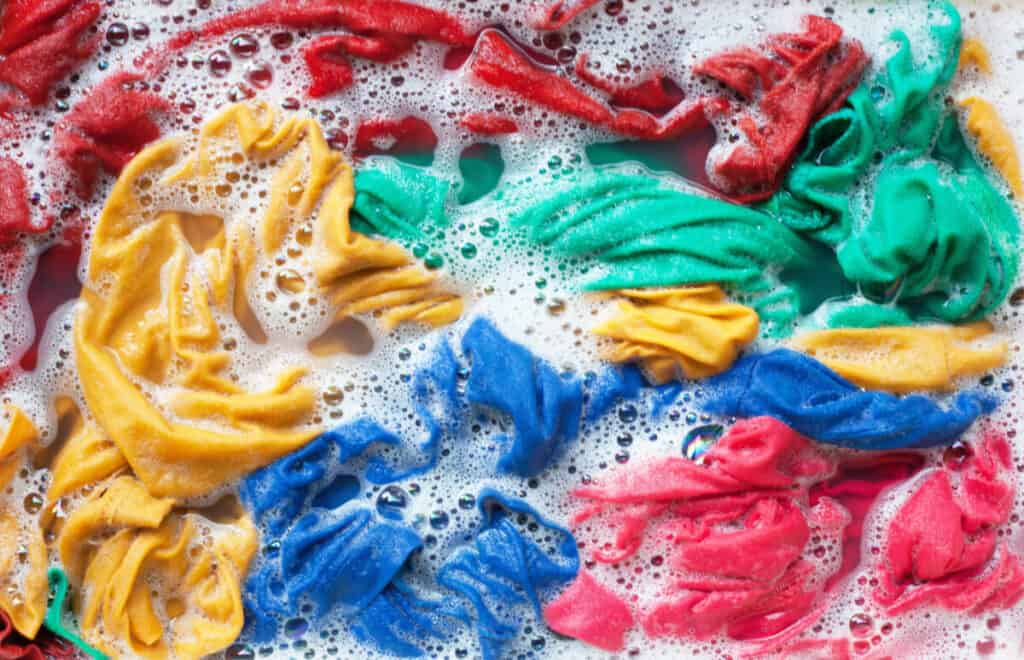What do you do when the thing that’s supposed to remove stains becomes a stain? It’s a puzzling predicament, but don’t worry. Detergent stain removal is easy and cheap!
To remove detergent stains out of clothes, rewash the stained clothes in a cycle without adding detergent. A rinse and spin cycle should dissolve any remaining powdered detergent stuck to the clothes. Using a higher water temperature setting can also help if the clothing allows for it. Stains from oily detergents can be removed by adding a tiny bit of Dawn dish soap to the wash cycle. Soaking in a vinegar solution can also be helpful.
While a simple rewash should get out most stains, sometimes it’s not enough. Let’s go over some detergent stain solutions available to you so that you can get those stains out.

Ways to remove laundry detergent stains
Laundry detergent stains are a super unfortunate accident, but the good news is that you can remove laundry detergent residue pretty easily! If you’ve taken out “clean clothes” only to find that there’s a waxy residue or pesky stains, don’t fret – We’ve got solutions for you to try.
We will also share ways that you can prevent laundry detergent stains (I know, I know, hindsight 20-20, the mistake can’t be undone…). But, this way you can prevent detergent stains for next time!
1. Re-wash at a warmer temperature
Sometimes if the water is too cold, the dissolution of a powdered detergent will be slowed, so all of the detergents won’t be washed out by the end of the wash cycle, leaving a soap residue. When you rewash the clothes, try using a higher water temperature. This should help any detergent still in the clothes to dissolve and rinse out of the clothes, leaving them stain-free.
To prevent this problem in the future, make it a habit to use a higher water temperature while washing clothes. If you’re not willing to do that, whether because you don’t want to sort clothes or you don’t want all your hot water to be used up by the wash, then good news! There may be another option, depending on your washing machine.
Pre-mix the detergent
If your washing machine lid doesn’t lock when you start the cycle, another solution for getting the powdered detergent to dissolve is to mix it with the water before putting a load of laundry into the machine.
Between the churning of the water’s entry and the sheer volume of it, this will give the detergent more opportunity to dissolve before it even touches your clothes, but it won’t work with some washing machines, such as front-loaded ones.
2. Try spot-treating with Dawn soap
If the detergent stains are oily rather than powdery, you can try using a tiny bit of Dawn dish soap to get out any oil spots. The soap should get out any oily residue, but don’t add too much. It’s dish soap, so it will make a ton of bubbles if you use too much in your washing machine, and it shouldn’t take much to get the stains out.
This soap should dissolve any oil-based or greasy substance that clings to your clothes. It will break down pretty much anything that shouldn’t be there.
As an alternative to putting it directly in the wash and risking a cascade of bubbles pouring from your washing machine, you could use it as a pre-treater by applying it directly to the stain and scrubbing with a toothbrush or other small brush. Put the treated clothes back through the rinse cycle, and they should be good as new.

3. Pre-soak in vinegar
Vinegar is a go-to for laundry stains, and it’s no different when detergent is the culprit. You’ll want to be careful with it, though, as it may end up discoloring the clothes themselves. Before you do any vinegar soaking, test a corner of the clothes that won’t be seen with the vinegar to see what the effect will be. When choosing vinegar to use for cleaning, always use white vinegar.
With clothes that are tested as vinegar-safe, you can use straight vinegar for soaking. You’ll generally only have to wait 15 to 30 minutes of soaking before they’re ready to rewash.
If you don’t want to risk exposing your clothes to straight vinegar, mix it with water. Dilute 1 cup of vinegar to a quart of water. Soak in the diluted vinegar solution for 30 to 60 minutes.
As the clothing soaks, scrub the stain by rubbing it against itself, by using a small brush, or by rubbing with your fingers. Once the time is up, throw it in the rinse cycle.
Why does laundry detergent stain clothes? Preventing future stains
When stains happen, it’s often because the detergent wasn’t able to dissolve properly. This can be for a few different reasons: the water is too cold, the water is too hard, or a load of laundry is too big. (Source)
1. Using too much detergent
Finally, if none of those prevention methods worked, it could be that you’re using too much detergent in the first place. For future loads, measure out less detergent: even using half of the recommended measurement should be fine.
2. Laundry load is too big
If the load is too crowded with clothes, the detergent’s access to the water is limited. The clothes soak up lots of the water, and what’s left might be below where the detergent can get to from where it is sitting on top of the clothes. At that point, the only time it has to dissolve is during the spin cycle.
That issue could be prevented in two ways. First, don’t overload your washing machine. It’s not worth the issues it could cause. The second solution is the same as the temperature solution: mix the detergent with the water before adding the clothes. That way, the load won’t have any way to prevent the detergent from dissolving.
3. Water is too cold
As we’ve discussed above, cold water causes detergent to dissolve a lot more slowly. Use warm water to prevent this or mix the detergent with the water before adding the clothes.
4. Water is “hard”
Hard water holds a lot of minerals, which can prevent the detergent from dissolving properly. If your water is hard, you can try using a water softener for your washing machine to help the detergent dissolve better.
You can tell if your water is hard from a filmy feeling on your hands after washing them, from spots on glassware or silverware that come out of the dishwasher, or from mineral stains on your clothes from washing them. (Source)
These are usually calcium or magnesium stains, which indicate high levels of these minerals in your water, and since the water you use is the same throughout your house, hard water from one source indicates hard water everywhere else in your house.
To combat hard water-causing detergent stains (or even mineral stains), use a water softener. Some water softeners even help your washing machine last longer, so this prevention method would be both more convenient and more cost-effective than taking the time and extra rinse cycles to get rid of stains whenever they happen.
Other cleaning articles
Some messes are easier to clean than others! Here are some other cleaning articles that may come in handy.
- How to clean a sheepskin rug
- How to clean the inside of a windshield
- How to get mascara out of clothes
- How to clean seat belts
- How to get crayon stains out of clothes
Cleaning
You can also check out the cleaning category to see which other posts we have. Simply click the button below!

Leave a Reply